Li Lyna Zhang
rStar2-Agent: Agentic Reasoning Technical Report
Aug 28, 2025Abstract:We introduce rStar2-Agent, a 14B math reasoning model trained with agentic reinforcement learning to achieve frontier-level performance. Beyond current long CoT, the model demonstrates advanced cognitive behaviors, such as thinking carefully before using Python coding tools and reflecting on code execution feedback to autonomously explore, verify, and refine intermediate steps in complex problem-solving. This capability is enabled through three key innovations that makes agentic RL effective at scale: (i) an efficient RL infrastructure with a reliable Python code environment that supports high-throughput execution and mitigates the high rollout costs, enabling training on limited GPU resources (64 MI300X GPUs); (ii) GRPO-RoC, an agentic RL algorithm with a Resample-on-Correct rollout strategy that addresses the inherent environment noises from coding tools, allowing the model to reason more effectively in a code environment; (iii) An efficient agent training recipe that starts with non-reasoning SFT and progresses through multi-RL stages, yielding advanced cognitive abilities with minimal compute cost. To this end, rStar2-Agent boosts a pre-trained 14B model to state of the art in only 510 RL steps within one week, achieving average pass@1 scores of 80.6% on AIME24 and 69.8% on AIME25, surpassing DeepSeek-R1 (671B) with significantly shorter responses. Beyond mathematics, rStar2-Agent-14B also demonstrates strong generalization to alignment, scientific reasoning, and agentic tool-use tasks. Code and training recipes are available at https://github.com/microsoft/rStar.
rStar-Coder: Scaling Competitive Code Reasoning with a Large-Scale Verified Dataset
May 27, 2025Abstract:Advancing code reasoning in large language models (LLMs) is fundamentally limited by the scarcity of high-difficulty datasets, especially those with verifiable input-output test cases necessary for rigorous solution validation at scale. We introduce rStar-Coder, which significantly improves LLM code reasoning capabilities by constructing a large-scale, verified dataset of 418K competition-level code problems, 580K long-reasoning solutions along with rich test cases of varying difficulty. This is achieved through three core contributions: (1) we curate competitive programming code problems and oracle solutions to synthesize new, solvable problems; (2) we introduce a reliable input-output test case synthesis pipeline that decouples the generation into a three-step input generation method and a mutual verification mechanism for effective output labeling; (3) we augment problems with high-quality, test-case-verified long-reasoning solutions. Extensive experiments on Qwen models (1.5B-14B) across various code reasoning benchmarks demonstrate the superiority of rStar-Coder dataset, achieving leading performance comparable to frontier reasoning LLMs with much smaller model sizes. On LiveCodeBench, rStar-Coder improves Qwen2.5-7B from 17.4% to an impressive 57.3%, and Qwen2.5-14B from 23.3% to 62.5%, surpassing o3-mini (low) by3.1%. On the more challenging USA Computing Olympiad, our 7B model achieves an average pass@1 accuracy of 16.15%, outperforming the frontier-level QWQ-32B. Code and the dataset will be released at https://github.com/microsoft/rStar.
Phi-4-Mini Technical Report: Compact yet Powerful Multimodal Language Models via Mixture-of-LoRAs
Mar 03, 2025Abstract:We introduce Phi-4-Mini and Phi-4-Multimodal, compact yet highly capable language and multimodal models. Phi-4-Mini is a 3.8-billion-parameter language model trained on high-quality web and synthetic data, significantly outperforming recent open-source models of similar size and matching the performance of models twice its size on math and coding tasks requiring complex reasoning. This achievement is driven by a carefully curated synthetic data recipe emphasizing high-quality math and coding datasets. Compared to its predecessor, Phi-3.5-Mini, Phi-4-Mini features an expanded vocabulary size of 200K tokens to better support multilingual applications, as well as group query attention for more efficient long-sequence generation. Phi-4-Multimodal is a multimodal model that integrates text, vision, and speech/audio input modalities into a single model. Its novel modality extension approach leverages LoRA adapters and modality-specific routers to allow multiple inference modes combining various modalities without interference. For example, it now ranks first in the OpenASR leaderboard to date, although the LoRA component of the speech/audio modality has just 460 million parameters. Phi-4-Multimodal supports scenarios involving (vision + language), (vision + speech), and (speech/audio) inputs, outperforming larger vision-language and speech-language models on a wide range of tasks. Additionally, we experiment to further train Phi-4-Mini to enhance its reasoning capabilities. Despite its compact 3.8-billion-parameter size, this experimental version achieves reasoning performance on par with or surpassing significantly larger models, including DeepSeek-R1-Distill-Qwen-7B and DeepSeek-R1-Distill-Llama-8B.
LongRoPE2: Near-Lossless LLM Context Window Scaling
Feb 27, 2025



Abstract:LongRoPE2 is a novel approach that extends the effective context window of pre-trained large language models (LLMs) to the target length, while preserving the performance on the original shorter context window. This is achieved by three contributions: (1) a hypothesis that insufficient training in higher RoPE dimensions contributes to the persistent out-of-distribution (OOD) issues observed in existing methods; (2) an effective RoPE rescaling algorithm that adopts evolutionary search guided by "needle-driven" perplexity to address the insufficient training problem; (3) a mixed context window training approach that fine-tunes model weights to adopt rescaled RoPE for long-context sequences while preserving the short-context performance with the original RoPE. Extensive experiments on LLaMA3-8B and Phi3-mini-3.8B across various benchmarks validate the hypothesis and demonstrate the effectiveness of LongRoPE2. Remarkably, LongRoPE2 extends LLaMA3-8B to achieve a 128K effective context length while retaining over 98.5% of short-context performance, using only 10B tokens -- 80x fewer than Meta's approach, which fails to reach the target effective context length. Code will be available at https://github.com/microsoft/LongRoPE.
Beyond Prompt Content: Enhancing LLM Performance via Content-Format Integrated Prompt Optimization
Feb 10, 2025Abstract:Large Language Models (LLMs) have shown significant capability across various tasks, with their real-world effectiveness often driven by prompt design. While recent research has focused on optimizing prompt content, the role of prompt formatting, a critical but often overlooked dimension, has received limited systematic investigation. In this paper, we introduce Content-Format Integrated Prompt Optimization (CFPO), an innovative methodology that jointly optimizes both prompt content and formatting through an iterative refinement process. CFPO leverages natural language mutations to explore content variations and employs a dynamic format exploration strategy that systematically evaluates diverse format options. Our extensive evaluations across multiple tasks and open-source LLMs demonstrate that CFPO demonstrates measurable performance improvements compared to content-only optimization methods. This highlights the importance of integrated content-format optimization and offers a practical, model-agnostic approach to enhancing LLM performance. Code is available at https://github.com/HenryLau7/CFPO.
rStar-Math: Small LLMs Can Master Math Reasoning with Self-Evolved Deep Thinking
Jan 08, 2025



Abstract:We present rStar-Math to demonstrate that small language models (SLMs) can rival or even surpass the math reasoning capability of OpenAI o1, without distillation from superior models. rStar-Math achieves this by exercising "deep thinking" through Monte Carlo Tree Search (MCTS), where a math policy SLM performs test-time search guided by an SLM-based process reward model. rStar-Math introduces three innovations to tackle the challenges in training the two SLMs: (1) a novel code-augmented CoT data sythesis method, which performs extensive MCTS rollouts to generate step-by-step verified reasoning trajectories used to train the policy SLM; (2) a novel process reward model training method that avoids na\"ive step-level score annotation, yielding a more effective process preference model (PPM); (3) a self-evolution recipe in which the policy SLM and PPM are built from scratch and iteratively evolved to improve reasoning capabilities. Through 4 rounds of self-evolution with millions of synthesized solutions for 747k math problems, rStar-Math boosts SLMs' math reasoning to state-of-the-art levels. On the MATH benchmark, it improves Qwen2.5-Math-7B from 58.8% to 90.0% and Phi3-mini-3.8B from 41.4% to 86.4%, surpassing o1-preview by +4.5% and +0.9%. On the USA Math Olympiad (AIME), rStar-Math solves an average of 53.3% (8/15) of problems, ranking among the top 20% the brightest high school math students. Code and data will be available at https://github.com/microsoft/rStar.
VPTQ: Extreme Low-bit Vector Post-Training Quantization for Large Language Models
Sep 25, 2024



Abstract:Scaling model size significantly challenges the deployment and inference of Large Language Models (LLMs). Due to the redundancy in LLM weights, recent research has focused on pushing weight-only quantization to extremely low-bit (even down to 2 bits). It reduces memory requirements, optimizes storage costs, and decreases memory bandwidth needs during inference. However, due to numerical representation limitations, traditional scalar-based weight quantization struggles to achieve such extreme low-bit. Recent research on Vector Quantization (VQ) for LLMs has demonstrated the potential for extremely low-bit model quantization by compressing vectors into indices using lookup tables. In this paper, we introduce Vector Post-Training Quantization (VPTQ) for extremely low-bit quantization of LLMs. We use Second-Order Optimization to formulate the LLM VQ problem and guide our quantization algorithm design by solving the optimization. We further refine the weights using Channel-Independent Second-Order Optimization for a granular VQ. In addition, by decomposing the optimization problem, we propose a brief and effective codebook initialization algorithm. We also extend VPTQ to support residual and outlier quantization, which enhances model accuracy and further compresses the model. Our experimental results show that VPTQ reduces model quantization perplexity by $0.01$-$0.34$ on LLaMA-2, $0.38$-$0.68$ on Mistral-7B, $4.41$-$7.34$ on LLaMA-3 over SOTA at 2-bit, with an average accuracy improvement of $0.79$-$1.5\%$ on LLaMA-2, $1\%$ on Mistral-7B, $11$-$22\%$ on LLaMA-3 on QA tasks on average. We only utilize $10.4$-$18.6\%$ of the quantization algorithm execution time, resulting in a $1.6$-$1.8\times$ increase in inference throughput compared to SOTA.
Mutual Reasoning Makes Smaller LLMs Stronger Problem-Solvers
Aug 12, 2024Abstract:This paper introduces rStar, a self-play mutual reasoning approach that significantly improves reasoning capabilities of small language models (SLMs) without fine-tuning or superior models. rStar decouples reasoning into a self-play mutual generation-discrimination process. First, a target SLM augments the Monte Carlo Tree Search (MCTS) with a rich set of human-like reasoning actions to construct higher quality reasoning trajectories. Next, another SLM, with capabilities similar to the target SLM, acts as a discriminator to verify each trajectory generated by the target SLM. The mutually agreed reasoning trajectories are considered mutual consistent, thus are more likely to be correct. Extensive experiments across five SLMs demonstrate rStar can effectively solve diverse reasoning problems, including GSM8K, GSM-Hard, MATH, SVAMP, and StrategyQA. Remarkably, rStar boosts GSM8K accuracy from 12.51% to 63.91% for LLaMA2-7B, from 36.46% to 81.88% for Mistral-7B, from 74.53% to 91.13% for LLaMA3-8B-Instruct. Code will be available at https://github.com/zhentingqi/rStar.
Phi-3 Technical Report: A Highly Capable Language Model Locally on Your Phone
Apr 23, 2024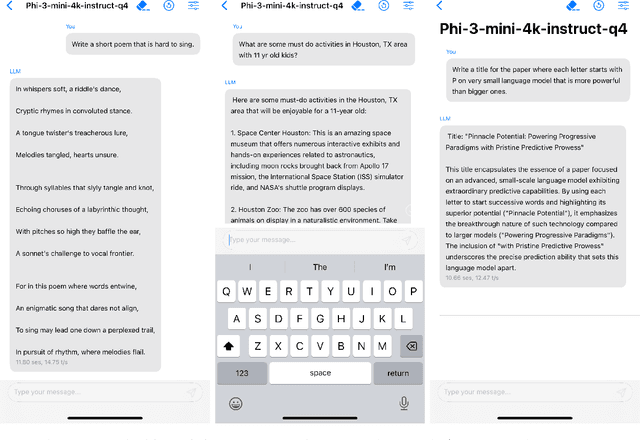

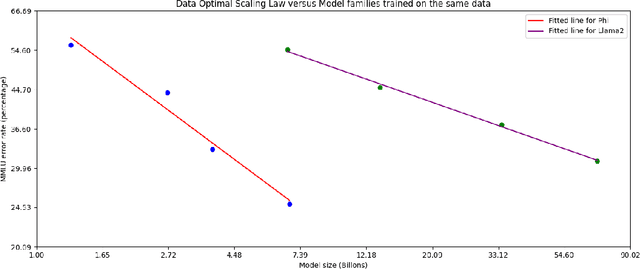
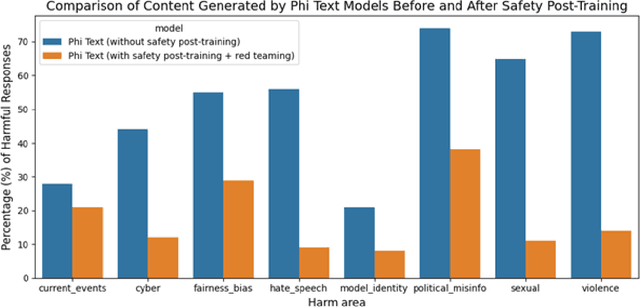
Abstract:We introduce phi-3-mini, a 3.8 billion parameter language model trained on 3.3 trillion tokens, whose overall performance, as measured by both academic benchmarks and internal testing, rivals that of models such as Mixtral 8x7B and GPT-3.5 (e.g., phi-3-mini achieves 69% on MMLU and 8.38 on MT-bench), despite being small enough to be deployed on a phone. The innovation lies entirely in our dataset for training, a scaled-up version of the one used for phi-2, composed of heavily filtered web data and synthetic data. The model is also further aligned for robustness, safety, and chat format. We also provide some initial parameter-scaling results with a 7B and 14B models trained for 4.8T tokens, called phi-3-small and phi-3-medium, both significantly more capable than phi-3-mini (e.g., respectively 75% and 78% on MMLU, and 8.7 and 8.9 on MT-bench).
LongRoPE: Extending LLM Context Window Beyond 2 Million Tokens
Feb 21, 2024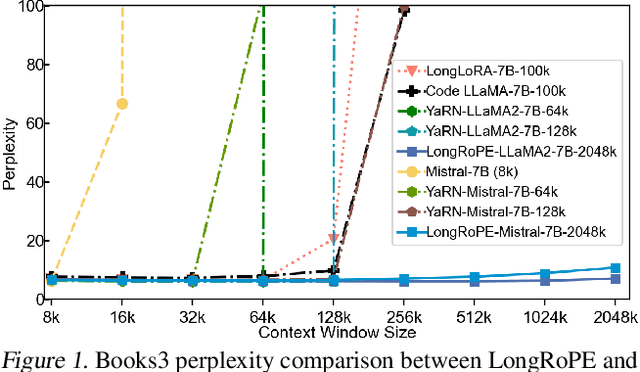
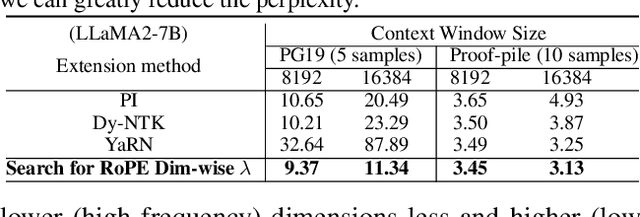
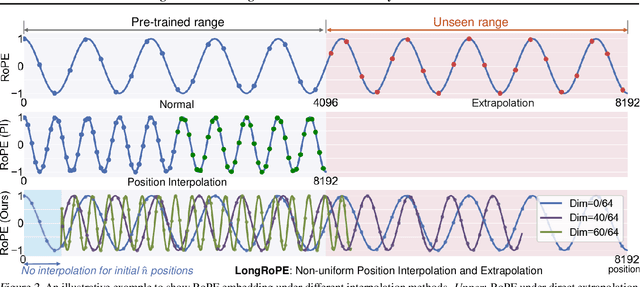

Abstract:Large context window is a desirable feature in large language models (LLMs). However, due to high fine-tuning costs, scarcity of long texts, and catastrophic values introduced by new token positions, current extended context windows are limited to around 128k tokens. This paper introduces LongRoPE that, for the first time, extends the context window of pre-trained LLMs to an impressive 2048k tokens, with up to only 1k fine-tuning steps at within 256k training lengths, while maintaining performance at the original short context window. This is achieved by three key innovations: (i) we identify and exploit two forms of non-uniformities in positional interpolation through an efficient search, providing a better initialization for fine-tuning and enabling an 8x extension in non-fine-tuning scenarios; (ii) we introduce a progressive extension strategy that first fine-tunes a 256k length LLM and then conducts a second positional interpolation on the fine-tuned extended LLM to achieve a 2048k context window; (iii) we readjust LongRoPE on 8k length to recover the short context window performance. Extensive experiments on LLaMA2 and Mistral across various tasks demonstrate the effectiveness of our method. Models extended via LongRoPE retain the original architecture with minor modifications to the positional embedding, and can reuse most pre-existing optimizations.
 Add to Chrome
Add to Chrome Add to Firefox
Add to Firefox Add to Edge
Add to Edge